The Nexus 7 (2013) Review
by Anand Lal Shimpi on August 22, 2013 6:00 PM ESTPlatform Power & Battery Life
The new Nexus 7 moves to a slightly smaller battery compared to its predecessor (15Wh vs. 16Wh). The result however is anything but a reduction in battery life. ASUS and Google worked hard to reduce platform power consumption as much as possible. I instrumented both Nexus 7s and measured total platform power, excluding display, to look at the impact of the silicon platform (SoC, PMIC, DRAM, eMMC, WiFi, etc...). The results are beyond impressive:
Idle power is cut in half compared to last year's model. This is by far the most important improvement as most mobile usage models tend to have long periods of idle time. We'll see these power gains reflected in our web browsing test which does have significant periods of simulated reading time between web page loads. The power reduction while running Kraken grows to just over 20%, and even while running Geekbench 3 we see a 16% drop with the new Nexus 7. Only our offscreen 3D test manages to draw more power on the new Nexus 7 than the old one, and that isn't taking into account the nearly 5x increase in performance on the new Nexus. In fact, as impressive as these numbers are - they are even more impressive when you take into account performance. To make a long story short, don't worry about the ~7% decrease in battery capacity as there are enough improvements in platform power and performance (and thus perf per watt) to more than make up for the smaller battery.
We'll start out with our WiFi web browsing test. Like all of our battery life benchmarks we run this test with all devices calibrated to 200 nits and connected to 5GHz 802.11 WiFi (if supported). The test itself cycles through a bunch of desktop websites at a very aggressive frequency. Our test ensures that both the CPU cores and wireless stack can reach their deep sleep states during simulated reading periods. The test continues until the battery is depleted.
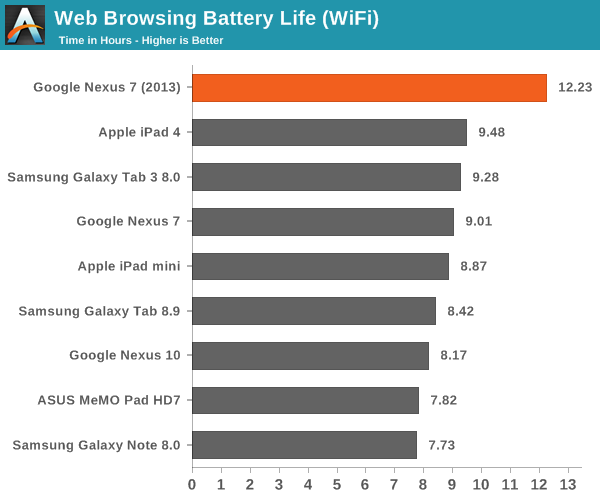
The new Nexus 7 does better here than any other small tablet we've ever tested. Remember that 50% decrease in idle platform power? That's exactly why we're seeing a 35% improvement in battery life compared to the original Nexus 7.
Our video playback test involves looping the playback of a 4Mbps 720p High Profile H.264 transcode of the last Harry Potter Blu-ray. All displays are calibrated to 200 nits.
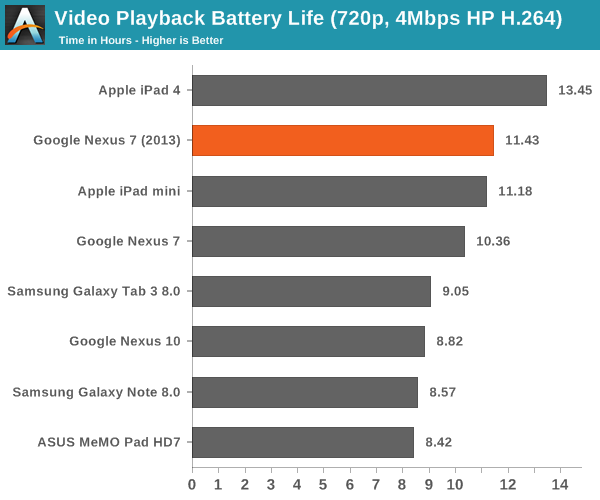
Video decode blocks are fairly well optimized to begin with, so there's not a ton of room for improvement here compared to last year's Nexus 7. Despite the ~7% shrink in battery capacity, the new model manages a 10% increase in battery life though. We also have the first small Android tablet capable of beating the iPad mini in a video playback test here - job well done ASUS/Google.
Our final test involves looping the Egypt HD benchmark until the battery is completely drained. Frame rates are capped to 30 fps to somewhat simulate actual gameplay and not penalize faster GPUs.
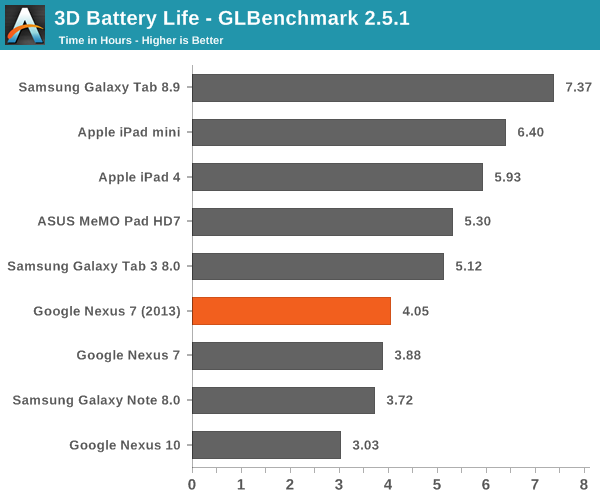
The new Nexus 7 manages to deliver slightly better battery life here despite driving higher frame rates and more pixels. Overall performance here isn't anything super impressive, the only average showing from the Nexus 7.
Google ships the Nexus 7 with an ASUS branded 7W charger, identical to the one you'd find in the box of a MeMO Pad HD7. Given identical chargers and battery capacities, there's no surprise the new Nexus 7 takes the same amount of time to charge as the MeMO Pad HD7 (~3.5 hours).
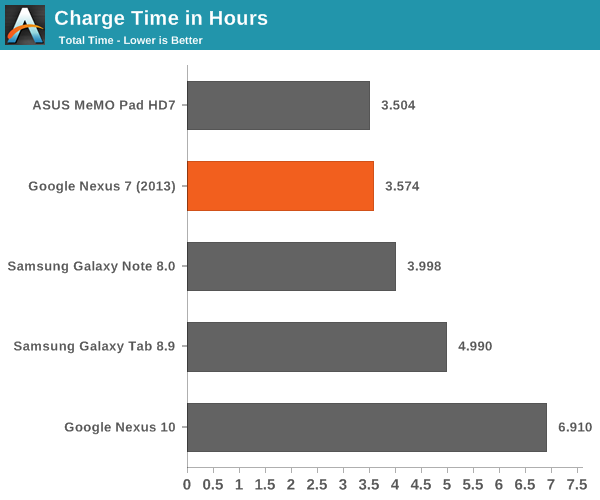
The new Nexus 7 also supports wireless charging by implementing the Qi standard. Charge time is a bit slower wirelessly as Qi can only charge at up to 5W. Brian tested Qi functionality in his mini review of the Nexus 7 and didn't have any issues.


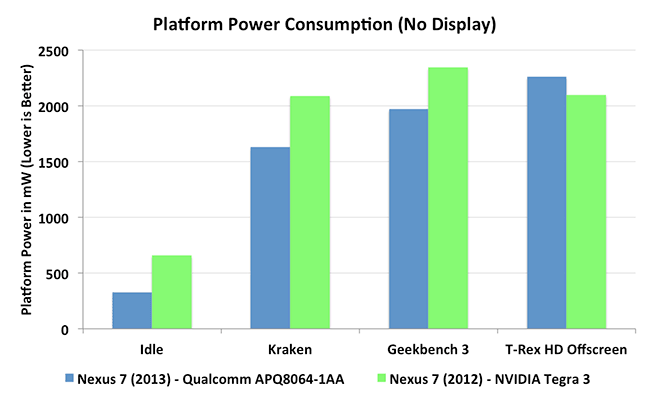









202 Comments
View All Comments
bubblesmoney - Wednesday, September 4, 2013 - link
Learn a bit more about android, quite a bit of what is state is inaccurate. Read all the parts, wanted to leave a comment on the blog but wasnt interested in leaving my email address on your website so didnt bother commenting there. Some simple things you need to know, get rid of the 'anti virus' you dont need it, you can read USB OTG hard drives, wifi drives, dvd players, cameras, wifi camera apps, dslr controller apps, miracast for wireless mirroring (does not need wifi for mirroring, stop comparing to airplay where you need a wifi signal, you dont need an app like you state in the article), nexus media importer can read NTFS hard drives, you can power hard drives with the nexus 7. So read up a bit more about android devices before writing a review as there is so much that is incorrect in the article (all parts) on your website. If you want to see wireless screen mirroring via miracast without using 'apps' or using hard drives etc then just search youtube for such videos or see my youtube channel veryannoyingname where i have uploaded hard drive being powered and read, dvd drive usb otg, etc you can also see some miracast videos so check it out if interested. See the other uploads and numerous playlists to use your android device better. Cheers.jb14 - Thursday, August 22, 2013 - link
Hi Anand thanks for the great review as always.I have a quick question for anyone here - i'm abit puzzled by the first two graphs on page one, ie the CalMAN display white point & Greyscale graphs. Here the Nexus 7 (2013) seems significantly worse than the original Nexus but there is no mention of this, however when the black levels are slightly worse on the new nexus in comparison this is picked up and explained. Am I missing something here or was the original nexus screen really that good in comparison, or do those two graphs have the nexus results the wrong way round so to speak? Are the differences too small to warrant highlighting? Thanks
darwinosx - Thursday, August 22, 2013 - link
Not a word about the fact that these are sold at cost.I have bought three of these as gifts but a retina iPad Mini will be a much better device when it arrives next month. 35 to 40% more screen real estate and real tablet apps instead of upsized apps plus three choices of memory sizes and LTE. This screen is too small for me though. Also the buttons are terrible.
sherlockwing - Thursday, August 22, 2013 - link
For 16:9 content, a 7.9" 4:3 screen only give you 13% more space. In exchange the Mini is almost an inch wider than N7 2013 while having much less bezel, not to mention Mini2 will end up being much more expensive than N7 2013 just like how N7 2012 vastly under priced the original mini.madmilk - Thursday, August 22, 2013 - link
I don't understand why people criticize the Nexus 4 and Nexus 7 for being sold nearly at cost. Are you really so eager to help Google, Apple, etc. make money? I'd prefer to keep it in my own pocket.BMNify - Thursday, August 22, 2013 - link
If subsidised hardware kill off the hardware manufacturer's then you will be left with a monopoly that is Google who can charge you more later and make money on Ad's too like they do now. This is the reason why selling at-cost or dumping is not desirable.sherlockwing - Thursday, August 22, 2013 - link
The sold at cost N7 is competing with the sold below cost Kindle Fire. The console market have the sold below cost Xbox competing with the sold below cost Playstation. Your logic doesn't work out in practice.BMNify - Thursday, August 22, 2013 - link
I have covered Amazon strategy in the below comments and console market is the perfect example of what will happen if all OS manufacturer's start dumping their hardware in the market. And console market is a much much smaller market where even 2-3 companies are enough but smartphones, tablets and laptops market is a very huge which needs healthy competition and many manufacturers to support all price points, device differentiation and quality.smartypnt4 - Thursday, August 22, 2013 - link
And? What's your point? How is it a negative that these are sold nearer to cost than Apple's 40%+ margin?Mivo - Friday, August 23, 2013 - link
End customers don't care if a device is sold at cost. I don't consider a low price a negative. The retina iPad mini won't be out next month, which is one of the main reasons why I now pre-ordered a N7 (hitting German shelves next week). I waited long enough.